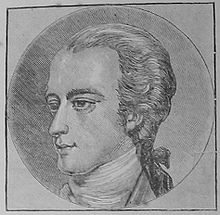| Revision as of 20:10, 24 May 2006 editMan vyi (talk | contribs)18,764 edits info← Previous edit | Revision as of 20:20, 24 May 2006 edit undoAwiseman (talk | contribs)Administrators22,341 edits fixed formatting, chopped up sentencesNext edit → | ||
| Line 18: | Line 18: | ||
| |casualties2=unknown | |casualties2=unknown | ||
| }} | }} | ||
| sey|governor]], Moses Corbet, in bed in ]. De Rullecourt convinced Corbet | |||
| The '''Battle of Jersey''' was a battle during the ] and was technically the last battle fought on British soil (coming after the ] in 1745). It was the last attempt by France to invade Jersey militarily. | The '''Battle of Jersey''' was a battle during the ] and was technically the last battle fought on British soil (coming after the ] in 1745). It was the last attempt by France to invade Jersey militarily. | ||
| On January 6, 1781, a few hundred French troops under Baron Phillipe de Rullecourt landed unnoticed at La Rocque, ], in the Island of ]. The adverse state of the tides meant that not all the troops, nor the equipment could be disembarked. They marched quickly to ] and surprised the |
On January 6, 1781, a few hundred French troops under Baron Phillipe de Rullecourt landed unnoticed at La Rocque, ], in the Island of ]. The adverse state of the tides meant that not all the troops, nor the equipment could be disembarked. They marched quickly to ] and surprised the island's ], Moses Corbet, in bed in ]. De Rullecourt convinced Corbet that thousands of French troops had already overwhelmed the island of Jersey Corbet surrendered. He was taken to the Royal Court building in the Royal Square and was persuaded to order ]'s commander Captain Mulcaster and 24-year old Major Francis Pierson's troops at ]'s Barracks to surrender as well. However, both officers, who were better informed as to the real military situation than Corbet, refused to surrender. Pierson then marched his troops to the Royal Square. | ||
| ] | ] | ||
| Peirson was killed early in the battle, but his troops, spurred on by Lieutenant Dumaresq, outflanked the French forces and defeated them. Baron de Rullecourt was also mortally wounded in the course of the battle. | Peirson was killed early in the battle, but his troops, spurred on by Lieutenant Dumaresq, outflanked the French forces and defeated them. Baron de Rullecourt was also mortally wounded in the course of the battle. | ||
Revision as of 20:20, 24 May 2006
| Battle of Jersey | |||||||
|---|---|---|---|---|---|---|---|
| Part of American War of Independence | |||||||
 "Death of Major Peirson" by John Singleton Copley "Death of Major Peirson" by John Singleton Copley | |||||||
| |||||||
| Belligerents | |||||||
| Great Britain | France | ||||||
| Commanders and leaders | |||||||
| Major Francis Peirson | Baron Phillipe de Rullecourt | ||||||
| Strength | |||||||
| unknown (prob. ~600) | unknown (prob. 500-1000) | ||||||
| Casualties and losses | |||||||
| unknown | unknown | ||||||
The Battle of Jersey was a battle during the American War of Independence and was technically the last battle fought on British soil (coming after the Battle of Culloden in 1745). It was the last attempt by France to invade Jersey militarily.
On January 6, 1781, a few hundred French troops under Baron Phillipe de Rullecourt landed unnoticed at La Rocque, Grouville, in the Island of Jersey. The adverse state of the tides meant that not all the troops, nor the equipment could be disembarked. They marched quickly to Saint Helier and surprised the island's governor, Moses Corbet, in bed in Government House. De Rullecourt convinced Corbet that thousands of French troops had already overwhelmed the island of Jersey Corbet surrendered. He was taken to the Royal Court building in the Royal Square and was persuaded to order Elizabeth Castle's commander Captain Mulcaster and 24-year old Major Francis Pierson's troops at Saint Peter's Barracks to surrender as well. However, both officers, who were better informed as to the real military situation than Corbet, refused to surrender. Pierson then marched his troops to the Royal Square.

Peirson was killed early in the battle, but his troops, spurred on by Lieutenant Dumaresq, outflanked the French forces and defeated them. Baron de Rullecourt was also mortally wounded in the course of the battle.
Later, parts of the 83rd Regiment of Foot attacked the French landing point at La Rocque and the French withdrew.
John Singleton Copley painted a dramatized version of the death of Major Peirson. That painting now appears on Jersey's 10 pound note and is in the Tate Gallery.
British units that took place in the battle include the 71st and 95th Regiments of Foot, the 78th (Highland) Regiment of Foot, and the Jersey Militia.

Sources
- Jersey Heritage Trust page
- BBC Page
- BBC My Island page
- Tate Gallery
- Regiments.org
- About Jersey
- JerseyWeb battle summary
This article about a battle is a stub. You can help Misplaced Pages by expanding it. |